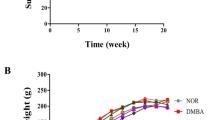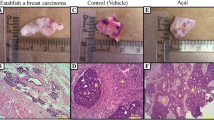Abstract
Purpose
There has been a considerable interest in the identification of natural plant foods for developing effective agents against cancer. Thus, the anti-tumour effects of oregano in the in vivo and in vitro breast cancer model were evaluated.
Methods
Lyophilized oregano (ORE) was administered at two concentrations of 0.3 and 3 % through diet. The experiment was terminated 14 weeks after carcinogen administration. At autopsy, mammary tumours were removed and prepared for histopathological and immunohistochemical analysis. Moreover, in vitro evaluation in MCF-7 cells was carried out.
Results
Low-dose ORE suppressed tumour frequency by 55.5 %, tumour incidence by 44 %, and tumour volume by 44.5 % compared to control animals. Analysis of rat tumour cells showed Ki67, VEGFR-2, CD24, and EpCAM expression decrease and caspase-3 expression increase after low-dose ORE treatment. High-dose ORE lengthened tumour latency by 12.5 days; moreover, Bcl-2, VEGFR-2, CD24, and EpCAM expression decrease and caspase-3 expression increase in carcinoma cells were observed. Histopathological analysis revealed a decrease in the ratio of high-/low-grade carcinomas in both treated groups. In vitro studies showed that ORE decreased survival and proliferation of MCF-7 cells. In ORE-treated MCF-7 cells, an increase in cells expressing sub-G 0/G 1 DNA content and an increase in the percentage of annexin V/PI positive MCF-7 cells were observed. In vitro, both caspase-dependent and possible non-caspase-dependent apoptotic pathways were found. The deactivation of anti-apoptotic activity of Bcl-2, a decrease in mitochondrial membrane potential, and the activation of mitochondrial apoptosis pathway were observed in the ORE-treated MCF-7 cells.
Conclusions
Our results demonstrate, for the first time, a distinct tumour-suppressive effect of oregano in the breast cancer model.






Similar content being viewed by others
Abbreviations
- AIF:
-
Apoptosis-inducing factor
- ALDH:
-
Aldehyde dehydrogenase
- BrdU:
-
5-Bromo-20-deoxyuridine
- CSCs:
-
Cancer stem cells
- FCM:
-
Flow cytometry analysis
- HDL:
-
High-density lipoprotein
- HG:
-
High grade
- EpCAM:
-
Epithelial cellular adhesion molecule
- LDL:
-
Low-density lipoprotein
- LG:
-
Low grade
- LOQ:
-
Limit of quantification
- MCF-7:
-
Human adenocarcinoma cell line, oestrogen receptor positive
- NMU:
-
N-methyl-N-nitrosourea
- ORE 0.3/ORE 3:
-
Experimental group with dietary administered oregano in a concentration of 0.3 and 3 %
- ORE:
-
Oregano
- VEGF:
-
Vascular endothelial growth factor
- VEGFR-2:
-
Vascular endothelial growth factor receptor-2
- VLDL:
-
Very low-density lipoprotein
References
Liu RH (2013) Dietary bioactive compounds and their health implications. J Food Sci 78:A18–A25
Yiannakopoulou ECH (2014) Effect of green tea catechins on breast carcinogenesis: a systematic review of in vitro and in vivo experimental studies. Eur J Cancer Prev 3:84–89
Cutler GJ, Nettleton JA, Ross JA, Harnack LJ, Jacobs DR Jr, Scrafford CG et al (2008) Dietary flavonoid intake and risk of cancer in postmenopausal women: the Iowa Women’s Health Study. Int J Cancer 23:664–671
Kang HB, Zhang YF, Yang JD, Lu KL (2012) Study on soy isoflavone consumption and risk of breast cancer and survival. Asian Pac J Cancer Prev 13:995–998
Zhang Y, Li Q, Ge Y, Chen Y, Chen J, Dong Y, Shi W (2013) Silibinin triggers apoptosis and cell-cycle arrest of SGC7901 cells. Phytother Res 27:397–403
Ma H, Lai F, Xie H, Wang J, Wang H (2008) Involvement of the Bcl-2 family members in Pinus massoniana bark extract induced apoptosis in HeLa cells. Phytother Res 22:1472–1476
Garvin S, Ollinger K, Dabrosin C (2006) Resveratrol induces apoptosis and inhibits angiogenesis in human breast cancer xenografts in vivo. Cancer Lett 231:113–122
Zhang XL, Guo YS, Wang CH, Li GQ, Xu JJ, Chung HY et al (2014) Phenolic compounds from Origanum vulgare and their antioxidant and antiviral activities. Food Chem 152:300–306
Srihari T, Balasubramaniyan V, Nalini N (2008) Role of oregano on bacterial enzymes in 1,2-dimethylhydrazine-induced experimental colon carcinogenesis. Can J Physiol Pharmacol 86:667–674
Begnini KR, Nedel F, Lund RG, Carvalho PH, Rodrigues MR, Beira FT, Del-Pino FA (2014) Composition and antiproliferative effect of essential oil of Origanum vulgare against tumor cell lines. J Med Food 17:1129–1133
Berrington D, Lall N (2012) Anticancer activity of certain herbs and spices on the cervical epithelial carcinoma (HeLa) cell line. Evid Based Complement Alternat Med 2012:564927
Savini I, Arnone R, Catani MV, Avigliano L (2009) Origanum vulgare induces apoptosis in human colon cancer CaCo2 cells. Nutr Cancer 61:381–389
Klonisch T, Wiechec E, Hombach-Klonisch S, Ande SR, Wesselborg S, Schulze-Osthoff K, Los M (2008) Cancer stem cell markers in common cancers—therapeutic implications. Trends Mol Med 14:450–460
Park SY, Lee HE, Li H, Shipitsin M, Gelman R, Polyak K (2010) Heterogeneity for stem cell-related markers according to tumor subtype and histologic stage in breast cancer. Clin Cancer Res 16:876–887
Soltanian S, Matin MM (2011) Cancer stem cells and cancer therapy. Tumour Biol 32:425–440
Scarpa ES, Ninfali P (2015) Phytochemicals as innovative therapeutic tools against cancer stem cells. Int J Mol Sci 16:15727–15742
de Beça FF, Caetano P, Gerhard R, Alvarenga CA, Gomes M, Paredes J, Schmitt F (2013) Cancer stem cells markers CD44, CD24 and ALDH1 in breast cancer special histological types. J Clin Pathol 66:187–191
Ito M, Shien T, Omori M, Mizoo T, Iwamoto T, Nogami T et al (2015) Evaluation of aldehyde dehydrogenase 1 and transcription factors in both primary breast cancer and axillary lymph node metastases as a prognostic factor. Breast Cancer [Epub ahead of print]
Anwar TE, Kleer CG (2013) Tissue-based identification of stem cells and epithelial-to-mesenchymal transition in breast cancer. Hum Pathol 44:1457–1464
Chekhun SV, Zadvorny TV, Tymovska YO, Anikusko MF, Novak OE, Polishchuk LZ (2015) CD44+/CD24− markers of cancer stem cells in patients with breast cancer of different molecular subtypes. Exp Oncol 37:58–63
Soysal SD, Muenst S, Barbie T, Fleming T, Gao F, Spizzo G et al (2013) EpCAM expression varies significantly and is differentially associated with prognosis in the luminal B HER2(+), basal-like, and HER2 intrinsic subtypes of breast cancer. Br J Cancer 108:1480–1487
Siddiqui JA, Singh A, Chagtoo M, Singh N, Godbole MM, Chakravarti B (2015) Phytochemicals for breast cancer therapy: current status and future implications. Curr Cancer Drug Targets 15:116–135
Gottardis MM, Jordan VC (1987) Antitumor actions of keoxifene and tamoxifen in the N-nitrosomethylurea-induced rat mammary carcinoma model. Cancer Res 47:4020–4024
Russo J, Russo IH (2000) Atlas and histologic classification of tumors of the rat mammary gland. J Mammary Gland Biol Neoplasia 5:187–200
Kubatka P, Kapinová A, Kružliak P, Kello M, Výbohová D, Kajo K et al (2015) Antineoplastic effects of Chlorella pyrenoidosa in the breast cancer model. Nutrition 31:560–569
Kubatka P, Kapinová A, Kello M, Kruzliak P, Kajo K, Výbohová D et al (2015) Fruit peel polyphenols demonstrate substantial anti-tumour effects in the model of breast cancer. Eur J Nutr [Epub ahead of print]
Mylona E, Nomikos A, Alexandrou P, Giannopoulou I, Keramopoulos A, Nakopoulou L (2007) Lymphatic and blood vessel morphometry in invasive breast carcinomas: relation with proliferation and VEGF-C and -D proteins expression. Histol Histopathol 22:825–835
Mosmann T (1983) Rapid colorimetric assay for cellular growth and survival: application to proliferation and cytotoxicity assays. J Immunol Methods 65:55–63
Fialová S, Slobodníková L, Veizerová L, Grančai D (2015) Lycopus europaeus: phenolic fingerprint, antioxidant activity and antimicrobial effect on clinical Staphylococcus aureus strains. Nat Prod Res 29:2271–2274
Kisková T, Jendželovský R, Rentsen E, Maier-Salamon A, Kokošová N, Papčová Z et al (2014) Resveratrol enhances the chemopreventive effect of celecoxib in chemically induced breast cancer in rats. Eur J Cancer Prev 23:506–513
Al Dhaheri Y, Eid A, AbuQamar S, Attoub S, Khasawneh M, Aiche G et al (2013) Mitotic arrest and apoptosis in breast cancer cells induced by Origanum majorana extract: upregulation of TNF-α and downregulation of survivin and mutant p53. PLoS ONE 8(2):e56649
Martins N, Barros L, Santos-Buelga C, Henriques M, Silva S, Ferreira IC (2014) Decoction, infusion and hydroalcoholic extract of Origanum vulgare L.: different performances regarding bioactivity and phenolic compounds. Food Chem 158:73–80
Hossain MB, Rai DK, Brunton NP, Martin-Diana AB, Barry-Ryan C (2010) Characterization of phenolic composition in Lamiaceae spices by LC-ESI-MS/MS. J Agric Food Chem 58:10576–10581
Kisková T, Ekmekcioglu C, Garajová M, Orendas P, Bojková B, Bobrov N et al (2012) A combination of resveratrol and melatonin exerts chemopreventive effects in N-methyl-N-nitrosourea-induced rat mammary carcinogenesis. Eur J Cancer Prev 21:163–170
Slee EA, Adrain C, Martin SJ (2001) Executioner caspase-3, -6, and -7 perform distinct, non-redundant roles during the demolition phase of apoptosis. J Biol Chem 276:7320–7326
Zhang J, Park HS, Kim JA, Hong GE, Nagappan A, Park KI, Kim GS (2014) Flavonoids identified from korean Scutellaria baicalensis induce apoptosis by ROS generation and caspase activation on human fibrosarcoma cells. Am J Chinese Med 42:465–483
Oh SB, Hwang ChJ, Song SY, Jung YY, Yun HM, Sok CH et al (2014) Anti-cancer effect of tectochrysin in NSCLC cells through overexpression of death receptor and inactivation of STAT3. Cancer Lett 353:95–103
Kim JA, Kim DH, Hossain MA, Kim MY, Sung B, Yoon JH et al (2014) HS-1793, a resveratrol analogue, induces cell cycle arrest and apoptotic cell death in human breast cancer cells. Int J Oncol 44:473–480
Gullett NP, Ruhul Amin AR, Bayraktar S, Pezzuto JM, Shin DM, Khuri FR et al (2010) Cancer prevention with natural compounds. Semin Oncol 37:258–281
Mehta RG, Murillo G, Naithani R, Peng X (2010) Cancer chemoprevention by natural products: how far have we come? Pharm Res 27:950–961
Cserni G, Voeroes A, Liepniece-Karele I, Bianchi S, Vezzosi V, Grabau D et al (2014) Distribution pattern of the Ki67 labelling index in breast cancer and its implications for choosing cut-off values. Breast 23:259–263
Dean M (2005) Cancer stem cells: implications for cancer causation and therapy resistance. Discov Med 5:278–282
Rennó AL, Alves-Júnior MJ, Rocha RM, De Souza PC, de Souza VB, Jampietro J et al (2015) Decreased expression of stem cell markers by simvastatin in 7,12-dimethylbenz(a)anthracene (DMBA)-induced breast cancer. Toxicol Pathol 43:400–410
Gao J, Liu X, Yang F, Liu T, Yan Q, Yang X (2015) By inhibiting Ras/Raf/ERK and MMP-9, knockdown of EpCAM inhibits breast cancer cell growth and metastasis. Oncotarget 6:27187–27198
Wu CH, Hong BH, Ho CT, Yen GC (2015) Targeting cancer stem cells in breast cancer: potential anticancer properties of 6-shogaol and pterostilbene. J Agric Food Chem 63:2432–2441
Ouhtit A, Gaur RL, Abdraboh M, Ireland SK, Rao PN, Raj SG et al (2013) Simultaneous inhibition of cell-cycle, proliferation, survival, metastatic pathways and induction of apoptosis in breast cancer cells by a phytochemical super-cocktail: genes that underpin its mode of action. J Cancer 4:703–715
Shelef LA (1983) Antimicrobial effects of spices. J Food Saf 6:29–44
Mills E, Ernst E, Singh R, Ross C, Wilson K (2003) Health food store recommendations: implications for breast cancer patients. Breast Cancer Res 5:170–174
Kaefer CM, Milner JA (2008) The role of herbs and spices in cancer prevention. J Nutr Biochem 19:347–361
Acknowledgments
This work was supported by the Scientific Grant Agency of the Ministry of Education of the Slovak Republic under the Contract No. VEGA 1/0108/16 and 1/0290/16 and by the Slovak Research and Development Agency under the Contract Nos. APVV-0325-07 and APVV-0550-11. This work was supported by the Grant “Martin Biomedical Centre” (ITMS: 26220220187), “Competence center for research and development in diagnosis and therapy”, code: 26220220153, and the Grant FNUSA-ICRC (No. CZ.1.05/1.1.00/02.0123), both projects co-funded from EU sources and European Regional Development Fund. This study was also supported by the project Medicínsky univerzitný park v Košiciach (MediPark, Košice) ITMS:26220220185 supported by Operational Programme Research and Development (OP VaV-2012/2.2/08-RO) (Contract No. OPVaV/12/2013). We thank to Eva Jakubovičová, Agáta Rešetárová, and Margaréta Kondeková for technical support.
Author information
Authors and Affiliations
Corresponding authors
Ethics declarations
Conflict of interest
The authors state that there are no conflicts of interest.
Rights and permissions
About this article
Cite this article
Kubatka, P., Kello, M., Kajo, K. et al. Oregano demonstrates distinct tumour-suppressive effects in the breast carcinoma model. Eur J Nutr 56, 1303–1316 (2017). https://doi.org/10.1007/s00394-016-1181-5
Received:
Accepted:
Published:
Issue Date:
DOI: https://doi.org/10.1007/s00394-016-1181-5




